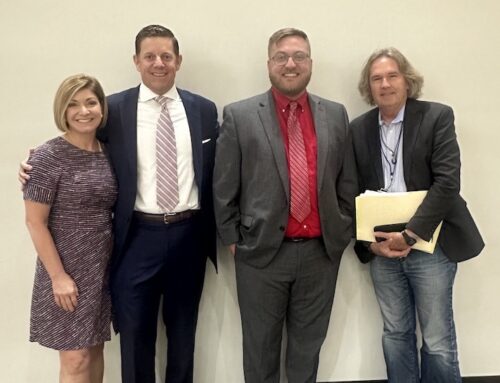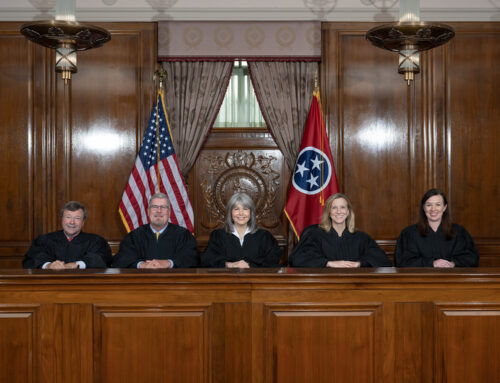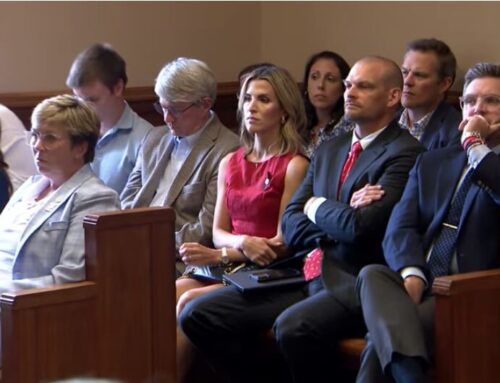Metro Nashville Police release report on Covenant School shooting
More than two years after a shooter blasted into the Covenant School in Nashville and killed six people, including three third-graders, the Metro Nashville Police Department on April 2 released a 48-page investigative case summary officially announcing the end of the case.
Nashville police concluded that 28-year-old Audrey Hale acted alone in planning and conducting the murders and that no one else provided assistance or support in the attack. Police also concluded that the people around Hale — her parents and mental health professionals who treated her — were not aware of her plans to attack the school and that no laws were broken when Hale purchased a series of guns. Hale was killed at the scene by police.
The report brings to a close an investigation that early on spawned a public records lawsuit — now on appeal — when police refused to release records. Police had said at the time that although they believed Hale acted alone, the case was still “open” and thus records could be withheld under the “ongoing investigation” exemption in the law. The lawsuit sought ordinary police records related to what police had discovered as well as access to Hale’s writings that police found in her car and home. Some of those writings were initially called a “manifesto” by police, a description that was later walked back.
With the investigation closed, police can now no longer block access to public records in the investigative file. This week’s report directs people to that file “for details regarding specific facts and information gathered during the investigation.”
However, access to writings created by Hale, which includes material in 16 notebooks, numerous other composition books and loose documents, will likely remain inaccessible, at least for now, based on a Davidson County Chancery’s Court’s ruling that her writings can be withheld under federal copyright law. The assertion of copyright was an unusual twist in the public records case. The parents of children at the Covenant school had claimed in court that Hale’s parents transferred ownership of their daughter’s writings to their children through a trust for the purpose of forever keeping them from becoming public. The Covenant parents believe that the release of her writings would inspire more school shootings and torment the surviving children. The appellate court case is expected to focus in part on whether federal copyright law is an exemption to the state public records law and can prevent police from releasing the shooter’s writings.
Hale created videos, some addressed to police and the public
Police also described for the first time a series of videos made by Hale that she intended for discovery after her death: “At this point, Hale then began recording what she referred to as the ‘Room Tapes.’ These were a series of videos she recorded using her cellphone that she intended to leave behind after her death to explain her motivations for the attack. Hale intended to record 13 of these videos but only recorded 12 prior to her death. The videos were recorded over a 14-month period and were anywhere between five minutes and 40 minutes in duration. Some of the videos were messages she recorded for family and friends to explain why she committed the attack and how she felt about them, with the intention the videos be given to the recipients after her death. Other videos appeared to be addressed to law enforcement and the general public, with the intention they explain her motivations and showcase how carefully she planned the attack.”
While these videos were not discussed in the chancery court hearings (those suing for records nor the parents likely knew about video messages), the chancellor who reviewed material given to her by police said in her ruling that “any original content and works of authorship in the possession of the Respondent which was created and put in tangible form by Hale including writings, journals, photographs, art, compilations and video content, fall under the definition of an original work of authorship” in federal copyright law. It’s unclear whether Hale’s parents transferred ownership of the “Room Tapes” to the Covenant parents — the documents filed in chancery court refer to Hale’s parents transferring to the Covenant parents “rights in the writings and Intellectual Property Rights” and the focus thus far has been on “writings.”
Police acknowledged in the report that the idea that Hale left behind a “manifesto” explaining her actions elicited a great deal of interest in the public, but said the description of a single manifesto was not accurate. “No single document, notebook, or digital device contains the answer to those questions. The answer is scattered throughout all the assembled material, which required a careful review of the material to understand Hale’s motive.”
Case summary gives timeline of shooter’s four years of planning
The case summary itself offers a detailed timeline of the shooting and an examination of Hale’s planning of it, which took place over more than four years. The report relies on information from Hale’s writings and other material she created and includes information about her psychological treatment in which therapists described increasing anger.
Police traced Hale’s interest in a school shooting to November 2017 when she recounted in a journal how she had watched several documentaries on such shootings. Her journals reflected more research and fantasies around school shooters that police said “began to turn into intentions in the summer of 2018.”
“She felt by ‘killing a bunch of children,’ she would no longer be ignored,” the report said. By December of 2018, her writings began to reflect she was actively planning an attack at the middle school she attended as a child, Creswell Middle. Later, however, she considered other targets, including Green Hills Mall and Opry Mills Mall, until she ultimately switched her plans to the school she attended as a child, the Covenant School.
The report outlines Hale’s obsessive and detailed planning for more than four years including purchasing the guns and even getting a tour of the Covenant School and taking pictures of the interior. She worked to hide her plans, finding places to hide her guns in her room after her parents, with whom she lived, discovered her gun purchases and tried to make her sell them.
Should Hale’s therapists interceded?
During all this time up to her death, Hale was in active treatment from therapists. The report says that at one point she “let slip (to a therapist that) she had suicidal and homicidal fantasies, though she was quick to explain she didn’t have a plan for either.”
Police investigated what Hale might have told her therapists about her plans to attack a school and gained access to her medical records with assistance from her parents. While detectives were able to get information and records from some of the people who treated Hale, they were unable to get records from Hale’s third and final therapist who was treating her when she carried out the murders.
The police report explained this by saying that the parents withdrew their consent for police to access medical records after earlier information from her medical records had been leaked to the media. At that point, the report says, Hale’s parents no longer had confidence that Metro Police would keep Hale’s mental health records confidential. “After being unable to devise a mechanism to satisfy their concerns and obtain their consent, and without any other legal mechanism being available to obtain those records, further attempts to obtain those records were abandoned,” the report says.
While the report doesn’t mention what information was leaked, in June 2024, the Tennessee Star published notes obtained from the police investigation that document that Hale had told one of her mental health providers that she had suicidal and homicidal ideations and desired to conduct a school shooting.
Police concluded that, based on the available records they reviewed, none of the mental health providers could have been held criminally culpable for failing to intercede:
Much has been discussed regarding the role played by those who offered Hale therapy and treatment for her assorted mental health disorders. Some of the discussions have revolved around whether those providers were criminally culpable for failing to intercede at various points in Hale’s life. It must be pointed out that not all of Hale’s mental health records were able to be obtained during the investigation due to factors outside of the control of the MNPD Homicide Unit. An assessment can only be made based on the information detectives were able to obtain during the investigation.
Based on the available records, it’s apparent the first two therapists who treated Hale did the best they could. The available session notes showed they focused on what they considered to be Hale’s most serious issues, which were her anger, anxiety, and depression. Hale was under the care of a psychiatrist and neuropsychologist at different periods, who were responsible for prescribing and monitoring Hale’s medication regimen. Whenever Hale showed indicators of her mental health deteriorating, her therapists addressed those issues quickly, including referrals to other providers for psychological assessments and treatment. The available records showed Hale was regularly prescribed medication to treat her assorted mental health disorders, with the prescribing physicians monitoring her interactions with the medication regularly. The only records found to show Hale had a negative interaction with those medications were either shortly after medication was adjusted or if Hale consumed alcohol while taking the medication. In those cases, the negative interactions appeared to have been rectified quickly.
As for VUMC, they conducted psychological assessments in 2019 and 2021, with Hale participating in an IOP following her assessment in 2019. During each assessment, they concluded Hale wasn’t suffering from psychosis at the time of the assessment and confirmed the diagnosis of the other providers. Based on the information available to the assessing physicians at the time and the medical viewpoints of the providers who assessed her, the best course of action for her conditions was an IOP. It should be pointed out mental health treatment requires a higher level of honesty between the patient and the provider than any other form of medical treatment. Conditions such as those Hale suffered from don’t often have physical symptoms which can be used to aid the provider in accurately diagnosing the patient’s condition, even if the patient is being less than honest. It’s well documented in the material Hale left behind she had no intention of ever telling her providers everything she was experiencing, no matter how harmful. Though she generally appreciated the therapy she received, she was adamant about not being hospitalized, and she recognized early in her planning and preparation that complete honesty would be detrimental to her plans. She had enough experience with the mental healthcare system to understand which topics to avoid with her providers and how to manipulate them into believing her documented issues with homicidal and suicidal ideations were well in her past. Based on the available records, Hale repeatedly denied to her providers of having current homicidal or suicidal ideations and learned how to be convincing with her denials. After reviewing the available information, nothing was found to show any criminal culpability or responsibility on the part of any of the providers who treated or assessed Hale.
Hale wanted notoriety, report said
The report discussed the intense media attention on the case. One section of the report addressed and dispelled theories by outside third parties on why Hale chose the Covenant School, the significance around the specific date of the attack and any connections she had with the victims. She chose Covenant because she wanted to kill children and she had good feelings about the school that made it a good place for her own death, police said. The date had no significance and she did not know any of the victims.
The report concluded that Hale was motivated by notoriety.
In short, the motive determined over the course of the investigation was notoriety.
Even though numerous disappointments in relationships, career aspirations, and independence fueled her depression, and even though this depression made her highly suicidal, this doesn’t explain the attack. As Hale wrote on several occasions, if suicide was her goal then she would have simply killed herself.
Throughout the writings and videos, Hale frequently commented that her death needed to matter and be remembered. Throughout her life, Hale experienced loneliness and disappointment. She felt abandoned and ignored by those she longed to befriend and engage with romantically, which angered her more than anything else. She believed that by simply committing suicide, she would be quickly forgotten and not even worthy of a footnote in history. She craved the notoriety Harris and Klebold attained following Columbine. This can be seen clearly with the frequent references in her writings and videos of how they became “gods” following their attack. This led to a deep desire on her part to become a “god” like them and other mass killers who attained notoriety, even if it meant infamy.
Hale longed for her name and actions to be remembered long after she was dead. She wanted absolute control of the narrative surrounding the attack, particularly her motives. She saw herself as a victim in the attack, and even though at times she saw herself equal to those she would kill, there were occasions she considered herself to be “the true victim” in the attack. She expected there would be books and documentaries dedicated to her and the attack, how her bedroom would become a museum dedicated to her memory, and expected her firearms, artwork, and writings to be prominently displayed in museums worldwide. She wanted her mental health to be a prominent topic of discussion and debate. Most disturbingly, she wanted the things she left behind to be shared with the world so she could inspire and teach others who were “mentally disordered” like her to plan and commit an attack of their own.
Hale felt she would be a failure if she killed less than 10 people during the attack. In that respect, she did fail, in no small part due to the actions of the faculty and staff at The Covenant. But she managed to attain the notoriety she craved simply by self-documenting her life and actions in a way no other mass killer has done before. She often complained how she didn’t know enough about the mental health history or motives of most mass killers, as nothing was publicly documented regarding their struggles. She hoped her attack would be different simply by providing years of writings, artwork, and digital media files which explained her motives and actions. In this respect, she succeeded.




